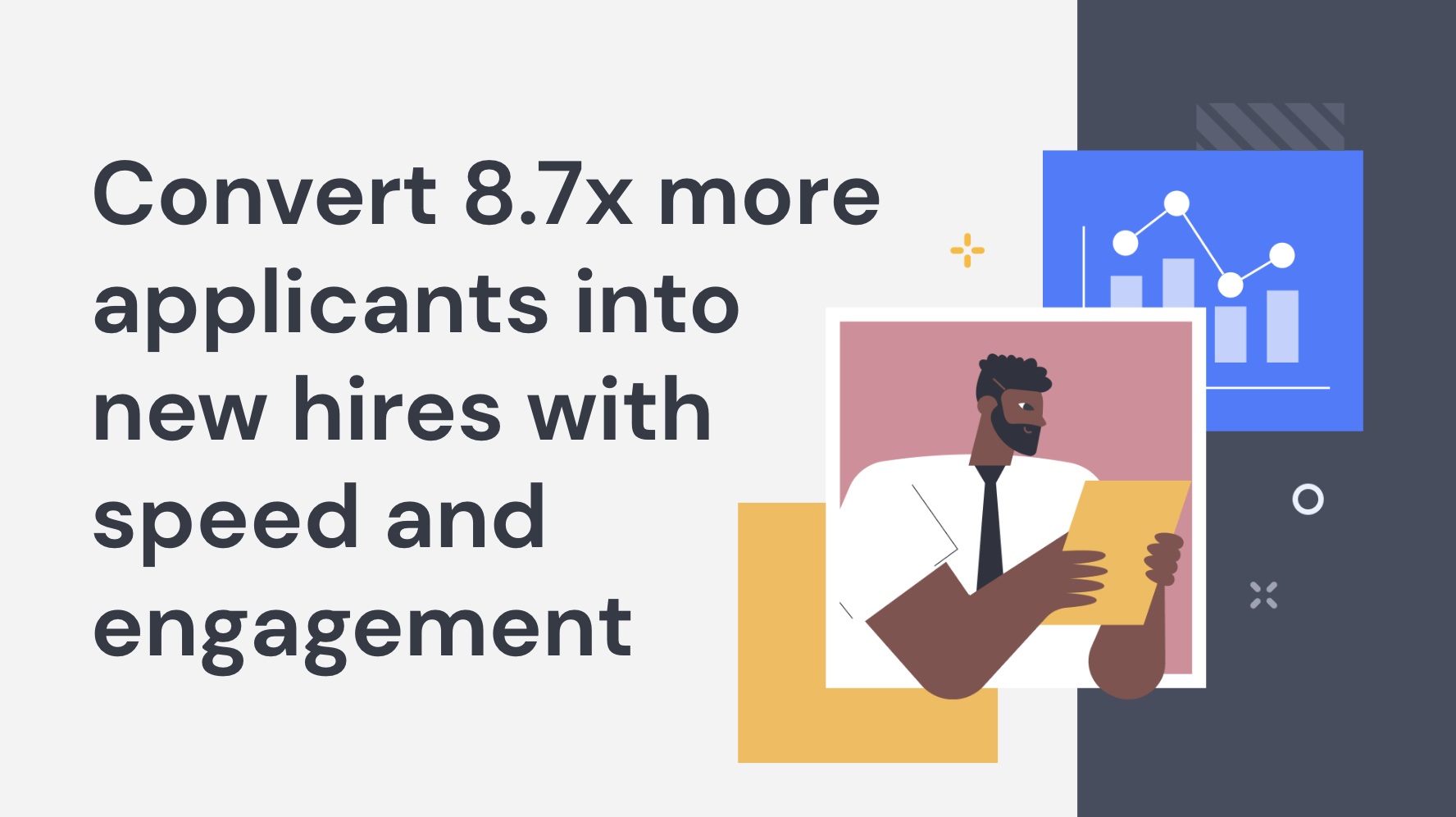Time to hire. Two words, one concept, immense impact on your business success.
A day more could mean losing out on top talent; a day less might risk skipping essential screening steps leading to an unfit recruit.
This post will help turn those days into hours by identifying bottlenecks in recruitment processes and streamlining them effectively for faster checkmates.
You'll also gain insights into key recruitment metrics to track progress and best practices for efficient hiring from real-life case studies.
Understanding Time to Hire
The time to hire, as its name suggests, measures the time it takes from when a candidate applies for a job until they accept an offer. This metric is more than just counting days on your calendar; it's about gauging the efficiency of your recruiting process and assessing candidate experience.
In essence, the quicker you can get qualified candidates through your recruitment funnel, the better. But why does this matter? Competition and cost are the two primary reasons why quick recruitment of qualified candidates is essential. The longer a job opening stays vacant, the more opportunities top talents have to explore other options—this could mean losing them to competitors or spending extra resources in keeping them engaged.
On average, time-to-hire spans between 24-30 days depending upon industry norms and specific roles. Of course, many factors come into play here such as hiring team’s efficiency or even external factors that might delay things unexpectedly.
This is where our focus needs to be sharp - understanding these intricacies gives us not only insight but also control over our own hiring success. With careful tracking of each stage in your recruiting process—from receiving applications up till finalizing job offer acceptance—you're able develop strategies that streamline procedures leading towards efficient human resource management.
An optimized time-to-hire indicates effective talent acquisition practices at work—and who doesn't want that?
Factors Affecting Time to Hire
The journey from job requisition to a candidate accepting a job offer can be influenced by several factors. It's like preparing for a marathon; you have your goal in sight, but numerous obstacles and conditions along the way will affect your finish time.
Internal Factors:
Your hiring team plays an instrumental role. The speed of their review process when candidates apply or the efficiency with which they conduct interviews can significantly impact time-to-hire metrics. Just as an efficient pit crew speeds up race times, so does an effective recruiting team accelerate the hiring process.
A streamlined recruitment funnel is crucial here - imagine it like having clear lanes on our marathon track.
External Factors:
-
The number of qualified candidates available: Like having more runners in our marathon may lead to longer finishing times if not managed well.
-
The attractiveness of the job offer: If we're running towards something exciting at the end line, wouldn't we run faster?
-
Candidate experience during interview processes impacts how quickly they decide whether or not this race is worth completing.
To shed some light on this topic let’s look at key stats: while Glassdoor research suggests that average 'time to fill' globally stands around 36 days (that's quite long.), companies usually achieve 'time to hire' between 24-30 days.
Understanding these factors can help identify potential roadblocks in your hiring journey, and remember, a smooth marathon track always leads to better race times.
Improving Time To Hire
Hiring the right talent is a race against time. A drawn-out hiring process can lead to losing qualified candidates, impacting business productivity and increasing costs. But don't worry. There are effective ways to speed up your recruitment funnel.
Optimize Your Recruitment Funnel:
An optimized recruitment funnel makes it easy for suitable candidates to apply and progress through the stages quickly. Get rid of unnecessary bottlenecks that slow down the process like redundant interviews or long-winded application forms.
Leverage Technology:
The use of an Applicant Tracking System (ATS) has been proven as a game-changer in improving time-to-hire. An effective ATS can automate repetitive tasks, making your recruiting team more efficient by freeing them from administrative duties.
Engage Candidates Early On
Candidate engagement starts when they first come across your job requisition and continues until they accept your job offer—or not. If you engage with potential hires early on, chances are high they will stick around even if external factors delay their journey into becoming part of your company's fabric.
Simplify Screening Processes
A complex screening process might be doing more harm than good by deterring quality applicants away from applying at all or slowing down those who do manage to apply. Streamlining these processes helps reduce time spent on unqualified applicants while speeding up responses for those who pass muster.
Key Stats: Did you know there are five effective ways we've found help companies improve their time-to-hire? It's true - each one involves keeping track of different stages in the recruiting funnel.
Measuring And Tracking Time To Hire
The first step in making sure your hiring process is efficient is to measure time. But what exactly does 'time to hire' mean? It's the number of days between a candidate applying for a job and accepting the job offer. This metric, used by half of all companies according to our recruitment metrics report, helps gauge recruiting efficiency.
A shorter time span indicates an efficient recruitment process. Yet, it doesn't always guarantee quality hires. That’s where another crucial element comes into play - tracking each stage of your recruiting team's progress with respect to each job requisition.
Your starting point should be defining clear goals or benchmarks based on past data and industry standards. It's reported that half of all businesses utilize this approach. By doing so, you can easily spot any potential delays or bottlenecks at different stages in the hiring pipeline.
Analyzing The Data For Improvement
You've gathered some pretty useful data here; now let's put it into action. Analyze these numbers carefully using recruiting analytics tools and software like an applicant tracking system (ATS). Not only will they help keep track but also suggest areas for improvement by highlighting inefficient processes in your recruitment funnel.
Workable’s guide on Time-To-Hire Metrics provides excellent insights on how measuring this critical factor allows businesses not just meet their hiring needs faster but also ensure high-quality talent acquisition as well.
Best Practices For Efficient Hiring
But, it's not just about filling that job opening; it’s also about ensuring an efficient recruitment process. Here are some best practices to make your hiring more effective and quicker.
A Streamlined Recruitment Process
The first step in achieving efficiency in hiring is by having a clear understanding of your talent acquisition needs. This includes accurately defining job requisitions and creating precise candidate profiles.
This clarity can significantly reduce time spent on sorting through unsuitable candidates and increase chances of attracting good ones who meet the criteria set out for each position. It'll give you a better starting point when assessing applications as they come in.
Strong Employer Branding And Talent Pool Management
In today's competitive market, establishing a strong employer brand can be instrumental in reducing the average time-to-fill roles. A positive reputation helps attract qualified candidates even before there's an actual need or vacancy – effectively creating a pool of ready applicants to tap into once openings arise.
Promoting Open Communication
Fostering open communication with potential hires goes beyond making them feel valued - it makes sure their expectations align with what you offer as well. When the hiring manager clearly communicates role requirements, responsibilities, company culture, and growth opportunities from day one – both parties get to avoid any unpleasant surprises later on.
Stats show that measuring time to hire helps identify weak spots in the recruitment process (source: Workable).
So, it's clear - having a robust hiring process not only helps fill job openings faster but also contributes to improved retention rates. And who doesn't want that?
Case Studies On Successful Time To Hire Strategies
Hiring strategies are a crucial aspect of business planning. We often view time to hire as an efficiency metric, but it tells us more than just how long we spent in the recruitment process. It's also about offer acceptance and finding quality candidates.
Glassdoor reports that the average time to hire ranges between 20 and 30 days, with significant variations across different industries. This gives us a starting point for analyzing successful hiring practices.
The Power of Effective Hiring: Company A
Company A is renowned for its effective hiring processes. The team reduced their long time-to-fill by implementing clear job requisitions early on, thus ensuring only suitable candidates applied.
This strategy not only improved their overall recruiting efficiency but also led to quicker job offer acceptance from applicants due to transparent expectations from the get-go.
Leveraging Technology: Company B
Another interesting case study is Company B which utilized modern technology tools like applicant tracking systems (ATS).
This helped them streamline their recruitment funnel by identifying unnecessary bottlenecks where good candidates were getting stuck or lost. As a result, they experienced higher candidate engagement leading towards faster hires within few days' time.
A People-Centric Approach: Company C
Last but certainly not least is company C who prioritized human resource management over strict metrics-led approaches in talent acquisition. Their success story lies in focusing on individual potential rather than strict job requirements.
They found that this led to candidates accepting job offers more quickly and becoming valuable team members in a shorter span of time, thereby reducing their average hire = day metric significantly.
FAQs in Relation to Time to Hire
What is the formula for time to hire?
The time to hire equation is pretty straightforward. It's simply the date a candidate accepts an offer minus the day they applied.
What is time to hire vs time to fill?
'Time to Hire' starts when someone applies and ends when they accept your job offer. 'Time to Fill', though, starts with posting a job and finishes once it's filled.
What is typical time-to-hire?
Average Time-to-Hire usually falls between 24-30 days. However, this varies based on factors like industry type or role complexity.
What impacts time-to-hire?
Different elements influence Time-To-Hire: company size, job level, recruitment process efficiency - even external factors such as market competition can play a part.
Conclusion
Time to hire. A simple concept with a significant impact on your hiring success.
You've learned the importance of this crucial metric, and how it shapes your recruiting efficiency and candidate experience. Remember, speed is essential but not at the cost of quality hires.
Identifying bottlenecks in your recruitment process can be transformative. You're now equipped to recognize these pain points, use relevant metrics for tracking progress, and apply effective strategies for improvement.
Your game-changer? Leveraging technology like applicant tracking systems (ATS) to streamline screening processes. Couple that with strategic business planning and strong employer branding - you're well on your way to reduce time-to-hire effectively!
In essence: Stay focused on enhancing candidate engagement throughout their journey from job requisition till offer acceptance. This ensures not just quick checkmates but successful ones too!
View our article on the 11 most influential women in the QSR industry today!





